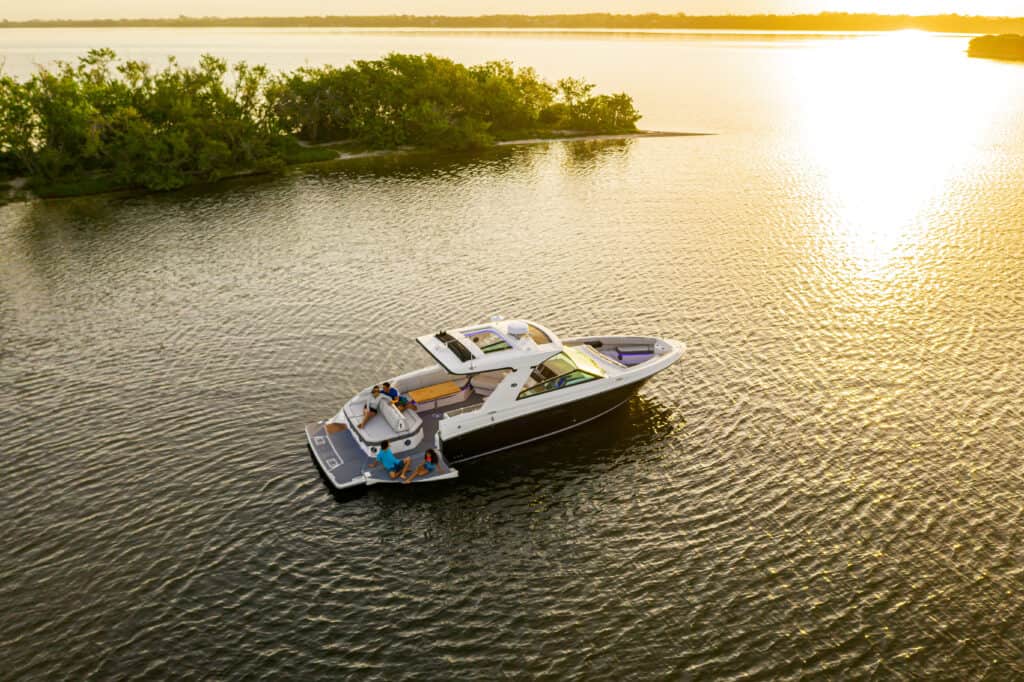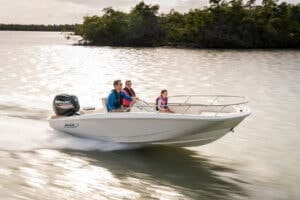Buying a boat is such a big milestone and a super exciting day for everyone involved.
If you’re ready to take the plunge, learn how boat loans at Trident Funding can help you sail through the process of financing a boat. You can check out our boat loan calculator to see how much boat you can afford and what to expect in terms of monthly boat loan payments. Then, apply online and get matched to a marine lender. We finance a variety of different types of boats including new and used fishing boats, deck boats, pontoon boats, yachts, and more.
Now that you know how you’re going to pay for your new boat, it’s time to find out more about the other costs involved with purchasing a boat, including regular boat maintenance. You need to know what’s entailed, how much it may cost you, and how to keep your boat in the best condition possible.
Boat Maintenance Checklist
1. Properly Store Your Boat
2. Wash and Clean Your Boat
3. Check the Fuel Level
4. Maintain the Battery
5. Check on the Boat Engines and Other Components
6. Keep an Eye on Oil Levels
7. Maintain Electrical, Plumbing, and HVAC Systems
Below are some important regular maintenance tips to keep in mind. It doesn’t matter what types of boats you’re interested in purchasing, they all need to be maintained, regularly washed, and the boat engines need to be checked on and serviced. It’s helpful to make yourself a checklist of each item on your boat and when you last cleaned or serviced it. For example, I cleaned the upholstery on August 1, 2022, and I last checked the battery on July 10, 2022, etc.
Properly Store Your Boat
One of the most important items on your boat maintenance checklist is knowing how to properly store your boat. This is going to vary depending on the type of boat you have, where you live, whether it’s hot all year round, or if it gets cold in the winter, and how often you plan on using your boat.
You can store your boat in your garage, in a shed, or on a trailer with a boat cover over it in your yard or driveway, if you have the space and if it’s permitted in your neighborhood. Other storage options include storing your boat on your private dock if you live on the water. However, the most common places to store boats are at a marina. Here, you can choose wet storage or dry storage. As the name suggests, wet storage is when your boat is kept in the water and dry storage is when your boat is stored out of the water, often on a boat rack, raised in the air by a crane. Sometimes dry storage is outside and sometimes it’s inside, especially in areas that have cooler climates and freezing temperatures.
Some of the pros of wet storage include that the boat is already on the water and easily accessible. You don’t have to worry about using a trailer or having the boat put on the water each time you want to use it. However, this isn’t an option if you live in an area where the water freezes during the winter. You will also need to hire a cleaner who dives under your boat to clean the bottom of the hull and remove dirt, debris, and barnacles.
Some of the pros of dry storage are that your boat is stored away from the elements and can be more protected during inclement weather and major storms. It can also be easier to clean the bottom of your boat if it isn’t in the water. However, there are disadvantages as well. A marina may not be able to accommodate a larger boat or a yacht and your boat may not be readily available for you. In fact, you may have to call the marina in advance when you want to use your boat.
Typically, wet storage is cheaper than dry storage but it depends on the area your boat is in and the amenities the marina offers. Expect to pay per foot for boat storage. Rates typically range from about $20 to $50 per foot for wet storage and anywhere from $50 to $200 per foot for dry, indoor storage. Some marinas charge per season and others charge per month.
When you’re calculating storage costs, remember to check out our boat loan calculator so you can calculate your estimated monthly boat loan payment too.
Wash and Clean Your Boat
If you keep your boat at home, and especially if it’s a smaller boat, you can easily hose it off yourself each time you use it. However, if you keep your boat at a marina, you can use the water there if it’s accessible, or you can hire someone to wash your boat for you. A boat should be cleaned inside and out, each time you take it out on the water. This is especially important if you take the boat out in saltwater. You want to try to prevent salt water damage, corrosion, and rust, as much as possible.
Cleaning your boat frequently can also prolong its lifespan. Cleaning a small boat may just take an hour, but longer boats may take a few hours to clean. Prices vary depending on oat size, type of vessel, and location, but expect to pay at least $10 per foot per cleaning. Don’t forget to clean the interior of your boat as well. If you have marine carpet, vacuum it, wipe down all surfaces, and don’t use harsh chemicals. Instead, use water and gentle soap.
When washing the outside of your boat, use a hose or a light pressure washer, the same pressure that you would use on your car. You can also use special marine soaps. You also need to wax the exterior of your boat. You can purchase the wax from a marine supplies store or you can get it professionally done. Waxing your boat is important to prevent oxidation and to keep it shiny and in good condition.
Check the Fuel Level
Just like you don’t want to run out of gas on the highway, you definitely do Not want to run out of fuel on the water. Fuel stations may be few and far between, and if you need a tow or someone to bring you fuel, it can be very expensive. Typically, marinas will have floating fuel stations onsite or will at least be able to tell you where the nearest one is. Different types of boats use different types of fuel. Some need diesel fuel, others use regular gasoline with low ethanol levels.
Some safe fueling practices for boat maintenance include:
- Put the right fuel in your boat! If you’re a new boat owner, you can read about fuel types in your owner’s manual, ask at the fuel station, look it up online, or even contact the boat manufacturer or seller if you have specific questions.
- Secure your boat to the dock
- Turn off the engine and extinguish all open flames
- Don’t top off your tank, fill it to about 90% because fuel slightly expands as the temperature rises
- If you fill up portable containers, do it on the dock, not on your boat
Maintain the Battery
Marine batteries are generally durable, but they still need to be maintained. You need to keep the battery charged and clean all the time. If your boat is located in an area that experiences extreme temperature changes, you may want to remove the battery and keep it inside at a moderate temperature. Don’t let it get too hot or too cold. When you’re making your boat maintenance checklist, don’t forget the battery.
Always follow the instructions that come with the marine battery, so you know how and when to properly charge it. Some other boat maintenance tips include filling the battery with distilled water and keeping the battery terminals and clamps clean. There should be an indicator that tells you how much water to put in and make sure you use distilled water, and definitely not saltwater. Only clean around the battery when it’s disconnected.
You can buy a special marine battery cleaner or you can make your own with baking soda and water until it forms a paste and then you can put it on a toothbrush or a small rag and wipe off corrosion. Other cleaning methods include using a wire brush to remove debris and then using petroleum jelly to prevent corrosion in the future. If in doubt, check with a boat mechanic before doing anything yourself.
Check on the Boat Engines and Other Components
Boat engines are extremely important; they help power your boat so you can make it safely to and from your destination. They’re also expensive to replace, so regular maintenance is necessary. It is definitely recommended to use a boat mechanic to check on your engines and maintain them unless you’re experienced with marine engines yourself. First time boaters and those with no desire to learn about the mechanisms of boats should have a local marine mechanic on speed dial. Your marina will be able to recommend one.
However, it’s always helpful for the mechanic to show you what he’s doing so you may know if something is amiss. Somethings to keep an eye on when it comes to boat engine maintenance include:
- Replace all engine fluids and fuel filters
- Inspect, clean, and replace spark plugs as required for your specific boat and engine type.
- Inspect the water pump
- Keep an eye on battery cables and grounding cable for corrosion and breaks
- Look at the propellers and the lower-unit seal
- Inspect all fuel hoses for wear and replace as needed
- Check out the steering system including the hydraulic hoses, ram, and end caps
- Inspect all electrical wiring
- Check out the water intakes and clear out any debris that may have built up
- Test the trim/tilt mechanism and make sure it can completely raise the outboard up and down
- Check on the navigation system and things like the radio and depth finder to make sure they work and you have the latest software update if applicable
These are just a number of things to be aware of and will vary depending on the type of engines you have. Obviously, outboard and inboard motors will need to be maintained and cleaned differently.
Keep an Eye on Oil Levels
Your car needs regular oil changes and your boat is no different. Check your oil levels frequently. Typically, boats need to have their oil changed every 50 to 100 hours, but you can find out the recommended oil change frequency of your make and model from the owner’s book, the manufacturer, or your mechanic.
Some people use their boats every few days and others only use them a few times a year, so how often you will need to change the oil also depends on how frequently you use your boat. There is specific oil to put in your boat that is marine grade and can be used in all four stroke marine engines, so don’t go dumping leftover car oil in your boat.
Maintain Electrical, Plumbing, and HVAC Systems
If you have a small fishing boat, you’re obviously not going to have a plumbing system or HVAC to maintain, but a yacht, a large sailboat, and even cabin cruisers, and some deck boats will have these systems and they will need to be monitored, cleaned, and regularly maintained.
Regularly check the following for comprehensive boat maintenance:
- Where each wire connects to and make sure all wires are connected and in good condition
- Label wires if possible
- Replace all melted or frayed wires because they’re a fire hazard
- Check fuses and circuit breakers
- Tighten or replace weak or loose connections
- Check for leaks in heads, faucets, and bathroom accessories
- Keep drains clean and unclogged
- Check for leaking pipes that may be below deck and may damage electrical systems
- Test the HVAC system before going out to sea
- Check remote controls are working for fans and A/C if you have them and replace batteries as needed
- Make sure air handler and evaporators are functioning
- Test the HVAC system with a supply and return air with a digital thermometer
What Does it Take to Maintain a Boat: The Wrap Up
Just like with cars, boats need maintenance; they need to be cleaned, and cared for. Different types of boats need different types of regular maintenance, but all boats will require some kind of upkeep. Regularly wash and clean the exterior and interior of your boat. Regularly check all systems, the engine, and all electrical components. Ask an expert to go through the boat with you from time to time to test things like the battery or the bilge pump and make sure everything is in working order. You don’t want to realize there is a problem once you’re out on the water.
What Does it Take to Maintain a Boat: Frequently Asked Questions
What Are Some Tips on Maintenance for Saltwater Boats?
Some tips on saltwater boat maintenance include:
- Rinse the saltwater off the boat immediately after taking it in an area with saltwater. Rinse it thoroughly from bow to stern.
- Use boat soap to clean the exterior of the boat after rinsing it
- Then, rinse off the boat soap for a second boat wash
- Wipe down the interior of the boat
- Clean the floors so no salt residue is left
- Wipe the engine down once it’s cool
- Spray engine with an anti-corrosive
How Often Should You Wash Your Boat?
You should be washing your boat often. Every time you use your boat, you should wash it and clean the interior. If you don’t use your boat for a month or so, you still need to wash it, to ensure dust or debris doesn’t collect on it. It’s good to get in the habit of washing your boat regularly, including washing the windows, and flushing your engine. Remember, to wipe out cup holders, wipe out storage areas, and clean the floors as well.
Do Different Types of Boats Need Different Regular Maintenance?
All boats need regular maintenance but different types of boats do need slightly different boat maintenance. For example, a boat that has gone in saltwater will need to be treated differently than boats that are only used in freshwater areas such as lakes.
Inboard motors and outboard motors need different maintenance and sailboats and motorboats are also going to need different types of maintenance. Typically, fiberglass and aluminum hulls need less maintenance than hulls made of other materials. Older boats may also require more maintenance and repairs than newer boats. A large boat such as a yacht may need more maintenance due to its size and the fact that it will have an HVAC system and a plumbing system.
How Does a Boat Toilet Work?
This is something so many people are curious about. Marine toilets (called heads) aren’t on all boats due to limited space, but you will see them on yachts, boats with cabins, and even some larger deck boats. They’re normally smaller than toilets in our homes but have the same parts: a seat, a bowl, and a flush. Boats don’t have on-board sewage systems, and instead have holding tanks to hold the waste.
Typically, there are two types of marine toilets: cassette toilets and pump-out toilets. Waste is stored in portable tanks if you have a cassette toilet and you may need to have an extra cassette on board, in case the first one gets full. You empty them at designated disposal points on land. Pump-out toilets are considered to be a bit more refined than cassette toilets. They include a larger tank and when you flush the toilet, the waste goes into this built-in tank. The tank is emptied using a suction hose at a pump-out facility.
Quality marine toilets aren’t too noisy, use minimal water and electricity but use enough water to rinse out the bowl each time it’s used. In addition to different types of tanks, there are also different types of flushes: manual and electric. Most boats newer than 2005 come with electric flushes. These are similar to flushes at home and are easy to use with the push of a button but do use more electricity than manual flushes. Manual flushes may use less electricity but clog easier and are more difficult to use. You will need to use a hand pump built into the side of the toilet.





